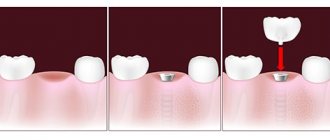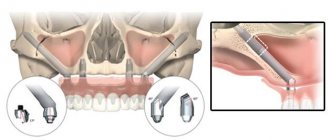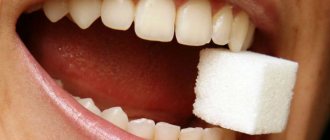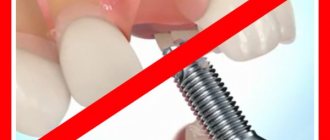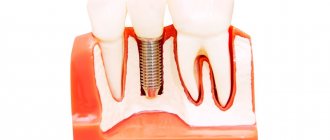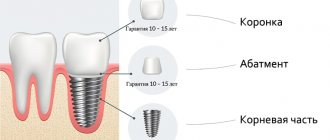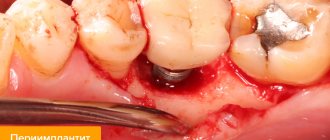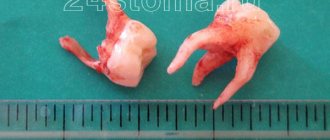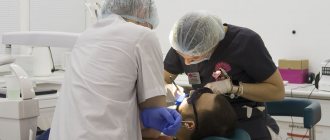821
Modern dentistry uses various implantation developments, among which single-phase dental implantation is predominantly distinguished. Implantation of an implant into bone tissue with an immediate load is gaining more and more popularity every year.
At the same time, the number of “fans” of this procedure is growing - obvious admirers and less positive-minded clients of dental clinics who do not trust dubious ideas and innovations, who consider this approach to be unreasonably ineffective.
The opinion of the latter can be explained by a preference for classics and standards, which does not allow us to fully evaluate new technological solutions in medicine.
In this article, we will talk about the single-phase implantation method, which, in comparison with classical methods, has greater capabilities.
What is basal implantation?
Let's try to give an analogy to make it clear what basal implantation is. If you place a stick in the ground using only the top loose layer, it will not hold well. But if you use deeper layers that are not washed out by water or exposed to other external influences, the stick can be secured much more firmly and will last longer. The same goes for basal dental implantation.
Basal complex is a type of implantation in one stage with immediate loading. The main difference between the basal implantation method and other protocols is that the installation of implants does not require the presence of alveolar cancellous bone, the most central part of the jaw bone tissue. It is used to install most classical implants. Basal implants work with fundamentally different sections: the cortical plate, basal bone, buttresses of the skull, nasal, zygomatic and sphenoid bone. To ensure that the bone and implant have a large contact surface, artificial roots are installed at a certain angle. Angling also helps to select the most suitable areas of bone and place implants bypassing the sinuses and nerve endings.
Unlike classic implants with a rough surface, basal implants are smooth and have a special antimicrobial coating. According to many studies, it is the absence of a rough surface in combination with the use of deep bone sections for implant installation that is an excellent prevention of peri-implantitis and, as a result, minimizes the risk of rejection in the long term. This is especially true in the presence of inflammatory processes in the oral cavity and periodontal tissues in particular.
The method is ideal for patients with complete edentia and is not suitable if only one tooth needs to be restored. The minimum is three missing teeth.
Screw designs
Compression (KOS – Compression Screw Design). A special feature of KOS implants is a special compression thread, which, when the rod is screwed in, expands and compacts the bone tissue.
Bicortical (BCS – Bi-Cortical Screw Design). BCS implants have a screw-shaped thread at the end with developed sharp blades. This shape is optimal for attachment to the basal (cortical) bone. In the area of the cancellous bone of the alveolar ridge there is a smooth rod, which ends with a head (abutment) for attaching the prosthesis. Implants have bending points to give the head the position necessary to fix the prosthetic structure.
BCS are represented by a large number of modifications with threads of different diameters and different numbers of turns. The thread blades of some modifications have holes and grooves for better osseointegration. The diameter of the threaded part ranges from 3.5 to 12 mm, the length varies from 10 to 38 mm.
The surface of the rods from the head to the thread is polished to prevent the spread of bacteria down the rod into the osseointegration area.
A wide range of BCS sizes allows you to select a design suitable for a specific clinical case. In case of thin cortical bone, implants with a small number of wide turns are used. If the basal bone is of sufficient thickness, it is advisable to use implants with a small diameter but a large number of turns.
Combined (compression + bicortical) implants (KOS Plus Implants). KOS Plus have two types of threads at the same time - a compression thread, cut in the upper part of the rod and intended for fastening into the cancellous bone, and a screw-shaped thread, located at the end of the rod and intended for cutting into the basal bone.
Basal method of dental implantation - indications and contraindications
The main restrictions on refusing basal implantation are the absence of 1–2 teeth, as well as general contraindications to any other surgical intervention. At the same time, Basal complex allows you to solve problems that classical implantation cannot solve.
Indications for basal implantation are complete or multiple absence of teeth, which is accompanied by the following problems and needs:
- advanced forms of periodontitis and other dental diseases, when the only way out is their removal, for example, with a high degree of mobility or loss, in the presence of strong cystic formations on the roots;
- acute and chronic forms of gum disease, accompanied by severe recession of the gingival contour and exposure of the roots;
- inflammation and acute atrophy of spongy bone tissue;
- desire to change dentures to implants;
- the need to speed up treatment;
- reluctance or inability to grow bone;
- advanced age of the patient;
- restoration of teeth in experienced smokers.
Flaws
Reasoned disadvantages of the procedure, as a rule, depend on the dental institution in which the rod was inserted.
Scientific studies have proven that single-phase implantation is possible in the absence of one unit, but experts consider this fact controversial.
Most clinics offer this service with the condition that at least three units are missing, and these are not all the disadvantages of the method:
- despite the use of local anesthesia during the procedure, the patient experiences minor pain;
- single-phase implantation is a surgical method of recreating the functions of the dentition, so the patient cannot do without painkillers for another 4 days after surgery;
- The instant method of implanting artificial roots is a labor-intensive and delicate work for dental specialists, so if a medical error is made during the implantation of the rod, it will be impossible to carry out the correction.
Despite a number of disadvantages, it should be recognized that the method still has more advantages. Moreover, for many patients whose medical history contains a number of contraindications to classical implantation, the single-phase technique becomes the only chance to gain a complete dentition and a beautiful smile.
However, dreams will come true only if the patient manages to find an experienced and professional specialist.
Features of the Basal complex
- No bone grafting is required.
- Basal implantation and tooth extraction are easily combined and are carried out in just one approach.
- Before the operation, a thorough 3D diagnosis is carried out, as well as three-dimensional modeling of the treatment process.
- At the surgical stage, templates are used to facilitate the process of implantation and allow their installation to be carried out as accurately as possible. During the implantation process, all manipulations are also monitored using 3D X-ray diagnostic technologies.
- Prosthetics take place within 3 days to ensure chewing load on the bone. Dentures can be fixed to implants using either cement or screws.
- When using zygomatic implants, they are fixed at an angle, bypassing the maxillary sinuses.
- For basal implantation, solid one-piece or one-component implants are used in an amount of at least 8 pieces.
Prices
Single-phase dental implantation, although not the cheapest procedure, however, has a more affordable cost compared to classic implantation. The total price tag for the service consists of the cost of several procedures:
- sanitation of the oral cavity - from 2,000 rubles;
- professional cleaning - from 1,000 rubles;
- tests, computer diagnostics, x-rays - complex from 1,500 rubles;
- removal of one problematic tooth - from 600 rubles;
- implantation - from 15,000 to 40,000 rubles;
- temporary prosthetics (plastic crown) - 800 rubles;
- permanent prosthetics - from 7,000 to 30,000 rubles.
Thus, the minimum cost of single-phase implantation of one tooth will cost the patient about 28,000 rubles.
In the video, the specialist talks about basal implantation, its advantages and disadvantages.
Why does the installation of basal implants take place without bone grafting?
Classic two-stage dental implantation is only possible if there is a sufficient amount of cancellous bone tissue. If there is a deficiency, bone augmentation is required before surgery. The basal method does not require this. Everything is explained simply:
- Other layers of bone are used, the density and hardness of which does not change due to the absence of teeth, since their chemical structure is different from the alveolar (spongy) layer.
- For the basal method, solid implants are used. They are often longer and thinner than the classic two-piece. This allows implants to be installed into the bone tissue at an angle with penetration into the deep layers.
- Basal implants are installed according to the principle of compression of bone tissue around its axis when screwed. That is, during implantation, the bone is not lost, but is compacted around the artificial roots. In this way, excellent primary stabilization is achieved with a force of up to 100 Newtons (for comparison: with the classical approach - no more than 30 - 40 Newtons). This approach has been used for more than 50 years for fractures and joint injuries. The principle of operation is also known by the name of the scientist-inventor G.A. Ilizarov.
- After fixing the implants in the bone, metabolic processes are immediately activated. The solution to this problem is taken over by the prosthesis. The patient chews food, improving blood supply to bone tissue. The cells are revived, replacing old and damaged ones, filling the space and increasing bone density around the artificial roots. Osseointegration occurs faster.
- The prosthesis has another important task - to fasten, connect or splint the implants with its frame, thus eliminating the risk of their mobility and displacement of the structure. The metal base connecting the implants to the prosthesis does not change its position even under heavy loads.
Reviews
Single-phase implantation opens up wide possibilities for the patient. There are no restrictions on prosthetics - not only a permanent, but also a removable dental structure can be fixed on a titanium artificial root.
If after reading the article you have a desire to share your own opinion about the innovative method of restoring the integrity of the dentition, leave your comment below.
If you find an error, please select a piece of text and press Ctrl+Enter.
Tags implantation single-phase implantation
Did you like the article? stay tuned
Previous article
How justified is the use of a conditionally removable denture?
Next article
The feasibility of using microprostheses in aesthetic dentistry
Pros and cons of basal implantation
- Time frame – prosthetics using this method will not take the patient much time. According to the protocol, implants should be “loaded” on day 3. Maximum taking into account the need to prepare for the operation, with all possible corrections of the prosthesis to suit the patient’s bite, compliance with the requirements for aesthetics and beauty of the smile, the entire treatment will take no more than 7 days.
- Appearance - the artificial gum is made of translucent acrylic, there is very little of it. When smiling and talking, no one will notice the border of the prosthesis. And the base will brilliantly cope with its task - it will protect the gums from injury in case of inflammation and hide existing cosmetic defects of the mucous membrane, if any.
- Rejuvenation is a pleasant “side” effect of prosthetics. Wrinkles around the mouth will be smoothed out due to the normalization of the functioning of the facial muscles.
- Pleasure from food - you can eat everything! Chewing food is welcome - it speeds up the process of bone tissue regeneration.
- Teeth can be restored even with a large deficiency of bone tissue.
- Contraindications - minimum. Even smoking, inflammation of bone tissue, periodontitis, and periodontal disease are not an obstacle to surgery. Implants work with deep parts of the bone, which are sterile and inflammation does not reach them.
- The implants are securely fixed - the fixation force is 2 - 3 times higher than that of classic models.
- Rehabilitation is very fast. Thanks to minimal trauma and the use of bio-membranes, which are created from the patient’s own blood plasma, tissues are quickly restored. There is only mild pain, comparable to the discomfort after tooth extraction. It goes away in 3 – 7 days. On an individual basis, the doctor prescribes antibacterial and painkillers that will reduce pain to “no”.
- The risk of implant rejection is minimal. Fixation in sterile parts of the bone tissue and preservation of the gums eliminate inflammation. An individually developed 3D plan for installing implants for each patient and the same control throughout the operation to install implants does not allow errors.
- The prosthesis is easy to care for.
- The prices are incredible. Basal implantation will cost less than classic two-stage implantation.
The main disadvantage of basal implantation is that Russia currently lacks qualified specialists. While implantation using the Basal complex method requires experience and knowledge. In one person, the doctor must be a surgeon with excellent knowledge of the anatomical structure of the maxillofacial system, an experienced orthopedist, an implantologist himself, as well as a competent user of software for modeling treatment results in 3D.
Possible complications
Surgery always involves a risk of complications. With single-phase implantation, the following negative manifestations are possible:
- Prolonged pain syndrome . Normally, the operated area should not cause pain for more than 4 days. In case of prolonged sharp pain, you should immediately consult a doctor to identify inflammatory processes and damage to nerve fibers.
- Swelling . Depending on the characteristics of the patient’s soft tissues, the presence of edema is acceptable for 7 days.
- Low-grade fever is considered normal for the first 3 days after surgery. If the thermometer does not drop from 37.5 for a longer period of time, this is a good reason to visit a doctor.
- Bruising, hematomas . I require constant supervision from a specialist.
- Prolonged numbness . It is a sign of damage to the facial nerve and requires drug therapy.
- Implant rejection . A rare serious complication. It occurs due to poor hygienic care of the oral cavity and medical errors during surgery.
Computer-aided treatment planning
It is impossible to prepare for basal implantation without 3D technologies. Bone tissue will not grow, so it is important to carefully and accurately plan treatment. The computer helps you select a model, calculate the angle of inclination of the implant, and choose the ideal location for it.
Computed tomography is also strictly required. From the images you can evaluate the quantity, quality and characteristics of bone tissue. Implants should not touch the sinuses or nerves. The examination results are processed through a computer, and by the time treatment begins, the doctor is very clear about the next steps. A detailed plan for the placement of implants and the developed parameters of the prosthesis helps you not to go astray.
In addition to computer technology, when creating individual orthopedic structures, special devices are used to measure the characteristics of the patient’s bite and occlusion.
Before installing the implants, again using virtual modeling, an individual template is prepared from elastic material for each specific patient. It is fixed on the gums - this stencil allows you to install the implant perfectly and without displacement in accordance with the chosen location.
What prostheses are used?
A model of the prosthesis is created before treatment using a computer program; the design is subsequently improved and verified using impressions, which are taken after the installation of basal implants. The mucous membranes need time to recover, so immediately after fixing the implants, the prostheses are not attached. It is recommended to wait 1 – 2 days.
For the first six months to a year, as a rule, an adaptive prosthesis with a metal frame and plastic crowns is installed (if desired, it can be left for its entire service life - up to 3 - 5 years). When the implants take root (and this will take a maximum of a year), the temporary prosthesis must be replaced with a permanent one. Crowns can be made of zirconium or metal ceramics.
But there is another option, which modern technologies allow: in 75% of cases, you can immediately install not a temporary, but a permanent prosthesis made of polymer materials. No need for re-prosthetics. Such a modern prosthesis lasts at least 10 years and is subject to adjustment to the bite directly in the patient’s mouth. The structure can be secured using cement or screw fastening.
What can be used instead of Basal complex?
One alternative solution is to install conventional removable dentures. However, the service life of orthopedic structures fixed only on the gums is short-lived, they are inconvenient to use, and they also lead to bone tissue atrophy, which requires frequent relining. An alternative may be solutions such as implantation of All-on-4 or All-on-6 - on four or six implants, respectively. These protocols are also used in cases of complete absence of teeth and involve implantation with immediate loading. But unlike basal implantation, they have certain limitations in the volume and quality of the jaw bone and are not used in cases of pronounced atrophic processes.
Product lifespan
The system requires careful daily hygienic cleaning. The service life of dental structures will depend on the quality of cleaning procedures.
Competent care does not require special experience and skills; it is enough to follow a few simple recommendations:
- purchase a brush with soft bristles and perform hygiene procedures at least 2 times a day;
- use antibacterial rinses after meals;
- Visit your dentist twice a year for a preventive examination;
- Use a home irrigator to remove food particles and bacterial plaque in hard-to-reach places.
Simple procedures will help maintain dental health and extend the life of dental products.
The service life of single-phase dentures depends not only on the quality of hygiene, but also on the material from which they are made.
The implant itself can serve its owner for at least 20 years; as for crowns, their life expectancy is as follows:
- metal ceramics - 12-15 years;
- metal-plastic - no more than 3 years;
- zirconium dioxide - more than 25 years.
What is better – classic or basal implantation?
Basal implantation is indicated for complete or almost complete absence of teeth. It is carried out both in case of bone tissue deficiency and in the presence of acute forms of periodontal tissue diseases. Classic implantation will not work in this case - the operation requires bone tissue augmentation. And this is extremely difficult, expensive and will take a lot of time. Therefore, in such situations, patients often hear a refusal and a recommendation to stay with removable dentures. We can safely say that today there is no full-fledged alternative to the basal implantation technique, especially in complex clinical cases.
Cost of treatment
The final price of basal implantation in Moscow depends on the complexity of the case, the manufacturer of the implants, as well as the materials of the selected denture. However, the patient always has a choice. Thus, the cost of basal implantation on the upper or lower jaw is 265 thousand rubles with an adaptive prosthesis, the service life of which is 3–5 years. With the installation of a permanent polymer ceramic-composite prosthesis, the installation of basal implants will cost 350 thousand rubles. With the fixation of a metal-ceramic prosthesis, the entire procedure will cost 450 thousand rubles.
Recommendations for choosing a clinic and implantologist
As mentioned above, basal implantation in the form in which it allows you to achieve high results is practiced today by very few specialists. In order not to run into a “fake” and not to become a victim of inexperienced doctors, but to get a guaranteed high result of the work done, I recommend paying attention to the following points.
The most important thing is that the doctor has a certificate issued by the International Implant Foundation. It is this association that has been actively studying and introducing into practice methods of one-stage implantation with immediate loading for many decades, including the basal complex. Currently, the foundation has introduced a five-step training that every specialist practicing these protocols must undergo. Naturally, the doctor must be accredited by the company that manufactures the basal implants.

